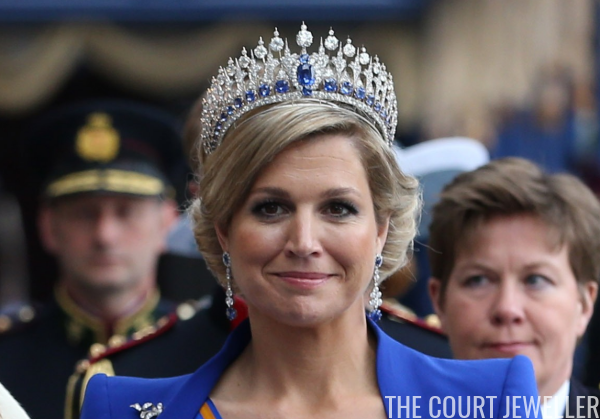 |
| Jasper Juinen – Pool /Getty Images |
This week, Queen Maxima of the Netherlands celebrated her 46th birthday. To mark the anniversary, we’re spending today with a sparkler that is becoming increasingly associated with her: the Dutch Sapphire Parure Tiara.
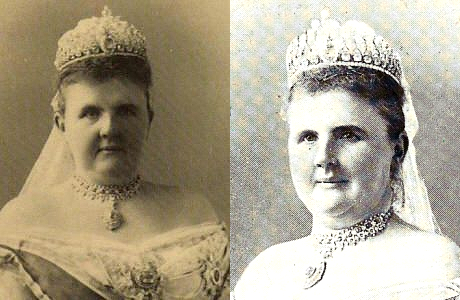 |
| Queen Emma of the Netherlands wears the tiara, ca. 1900 |
Like last weekend’s tiara, the Dutch sapphire is often incorrectly said to have been made by Mellerio dits Meller. That long-standing statement has been corrected numerous times over the past two decades — notably, in a book about Dutch jewelry by Rene Brus, and then again by Vincent Meylan in his book about Mellerio. It’s also often said that the tiara was designed by the great Oscar Massin, but while the makers may have taken inspiration from one of his sketches, that seems also to be untrue. In 2013, George Hamel presented new research on the tiara, concluding that it was ordered by King Willem III of the Netherlands for his wife, Queen Emma, in 1881 from a Dutch firm, Maison van der Stichel.
Hamel’s discovery came via a newspaper clipping from the time of Queen Wilhelmina’s inauguration. Queen Emma wore the sapphire tiara for the ceremony, and Maison van der Stichel is named as the maker of the piece. For more on Hamel’s findings, I recommend Erik Schoonhoven’s excellent article (in English) on Hamel’s research.
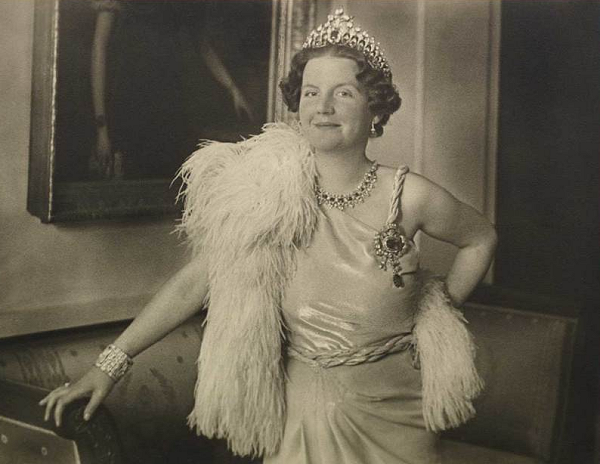 |
| Queen Juliana wears the tiara in a photo taken by her husband, Prince Bernhard, during a pause in an official state portrait session, 1937 (Wikimedia Commons) |
The tiara was originally set on a frame that allowed it to be dismantled into parts, including a haircomb. The central sapphire element can be detached and worn as a brooch. (Hamel’s findings showed that the central element was not, as was often said, an heirloom from Willem III’s mother, Queen Anna Pavlovna.) In 1928, the tiara was overhauled by Van Kempen (then the Dutch court jeweler), who made alterations to the golden frame, making it one complete frame rather than a series of detachable ones, and removed and replaced some gemstones.
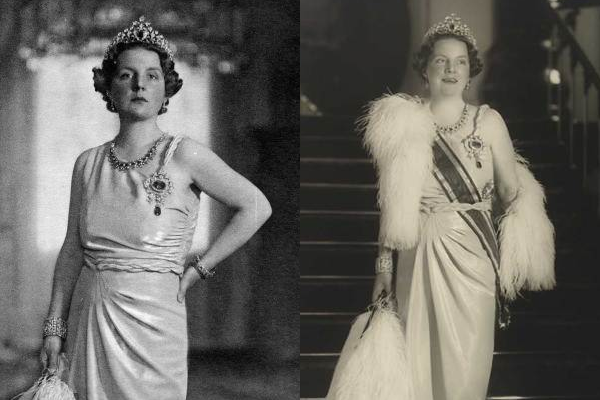 |
| Queen Juliana wears the tiara in a set of portraits taken in 1937 by Franz Ziegler (Wikimedia Commons) |
The tiara itself is something of a Gothic wonder. More than six hundred diamonds are set in the piece, some on thin wires to produce an en tremblant effect. The sapphires are Sri Lankan, including the grand central sapphire, which weighs in at around 44 carats.
Queen Emma died in 1934, and it seems likely that she left the tiara directly to her granddaughter, the then-Princess Juliana. To my knowledge, Juliana’s mother, Queen Wilhelmina, was never photographed in the tiara. Juliana wore the tiara in a notable series of official portraits taken in 1937 by Franz Ziegler. (The necklace she often wore with the tiara, including in the portraits above, is now often worn by the Dutch royal women on a tiara frame.) Juliana wore the tiara throughout her reign, including the return dinner during a 1972 state visit to the United Kingdom.
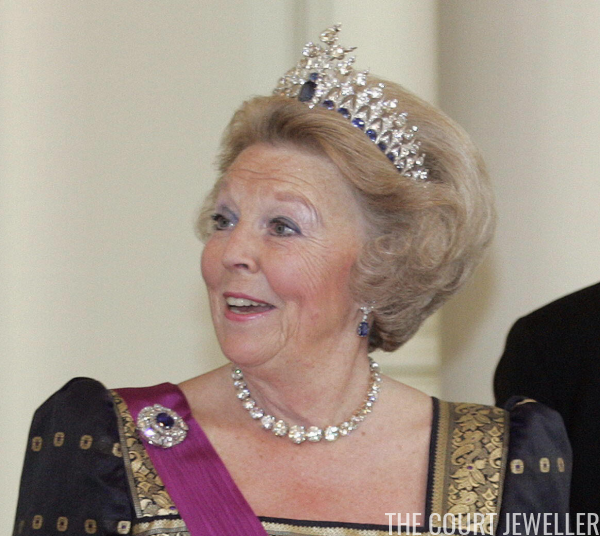 |
| BENOIT DOPPAGNE/AFP/Getty Images |
As she did with so many of the family’s grand jewels, Queen Juliana placed the tiara in the family’s foundation. After Juliana’s abdication in 1980, the new Queen Beatrix began wearing the tiara at grand state functions. The piece looked slightly smaller on Beatrix, but that’s because it sank a bit into her famous hairstyle, camouflaging the lower parts of the tiara. Above, she wears the tiara during a 2006 state visit to Belgium.
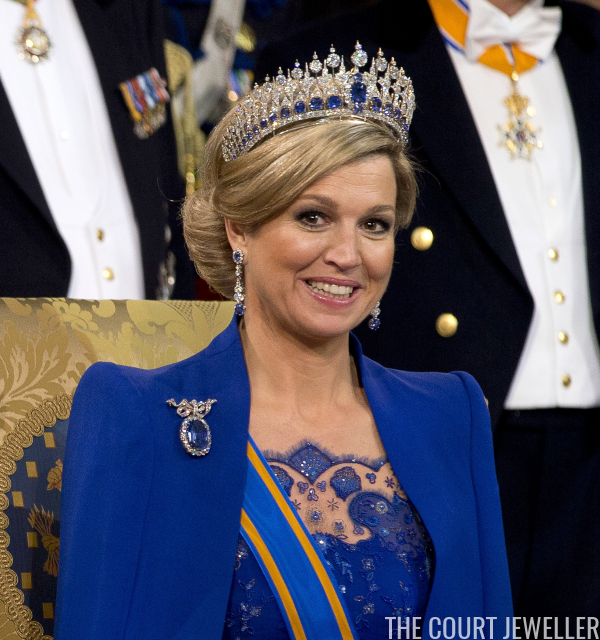 |
| Peter Dejong – Pool/Getty Images |
In 2013, ahead of the inauguration of King Willem-Alexander, more alterations were made to the tiara. The base was supplemented so that the piece now sits slightly higher on the wearer’s head. Queen Maxima wore the tiara for the first time in public at her husband’s inauguration, but on that occasion, she didn’t actually wear the complete piece. The tall central diamond plume of the tiara was removed for the event and replaced with a single round brilliant, giving the tiara a curved shape resembling a Russian kokoshnik.
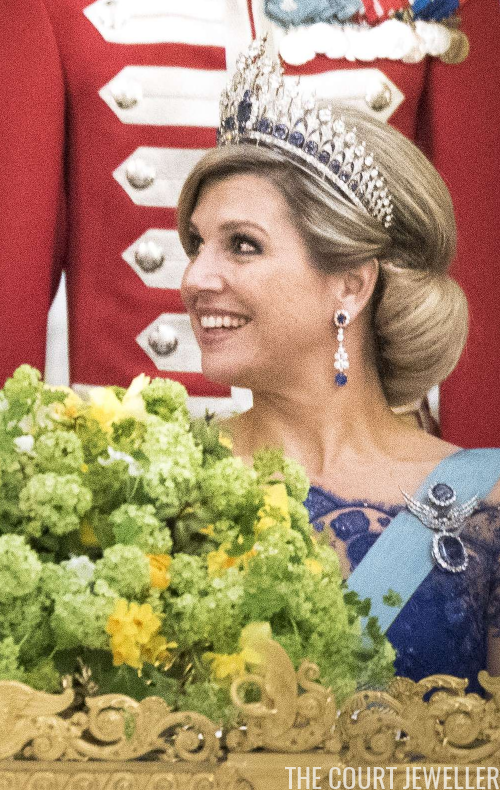 |
| Niels Ahlmann Olesen/AFP/Getty Images |
That diamond alteration wasn’t permanent, though. Queen Maxima wore the impressive full version of the tiara for the first time in public during a state visit to Denmark in March 2015, even repeating her inauguration gown for the occasion. The side view of the full tiara, shown here during the state banquet, really emphasizes the Gothic design of the tiara, which soars skyward like a cathedral.
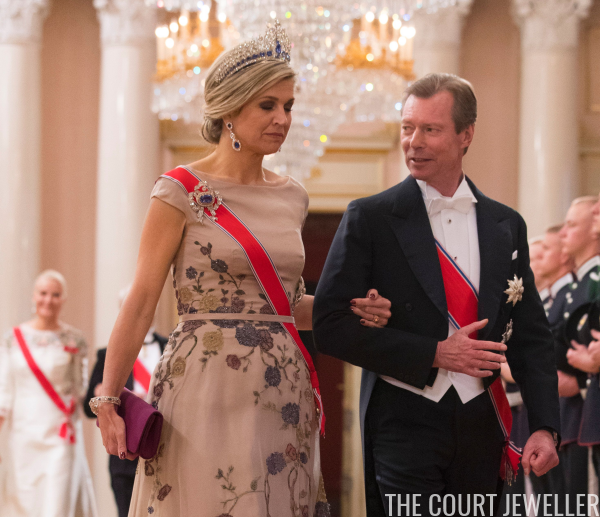 |
| HAAKON MOSVOLD LARSEN/AFP/Getty Images |
We recently saw the tiara in Norway, where Maxima wore it for a gala dinner honoring the 80th birthdays of King Harald V and Queen Sonja. She’s paired the tiara with a variety of sapphire jewels from the vaults (including the bracelets that were made to go with the tiara in 1881) on each occasion, but she’s smartly decided not to wear a necklace with the piece. It doesn’t need the competition — it sparkles more than enough on its own!
Leave a Reply